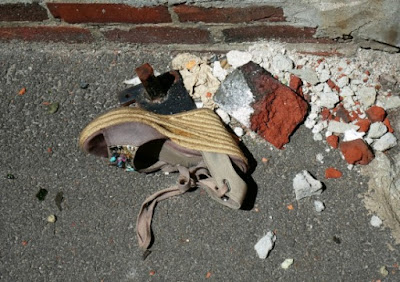Forensic Science has Limitations
The two types of science used in discussions of origins are forensic and operational, the latter being used to describe science that is testable, repeatable, observable, and so on in the present. Forensic science attempts to explain the past by working backward from evidence in the present.
Suppose you came upon some rubble that included broken bricks, a shoe, and other things. Is there an interesting story or did someone just throw things there? Someone involved in forensics would attempt to piece together the details if there was a need to do so.
I recently saw an episode of CSI where there were no witnesses and no suspects in a murder investigation. The crime lab team members were attempting to reconstruct the sequence of events and getting nowhere. Then they realized they were doing things backward, and this led to finding a crucial piece of evidence. While only a story, it illustrated how people can make wrong assumptions and have to change when they have new ideas — and new evidence.
Of course, a reliable eyewitness can supplement the forensic work, or even trump it. Sometimes science regarding the past can be tainted by agendas (especially when secularists want to prove evolution) or have conflicting pieces of evidence. Historical records by eyewitnesses become increasingly important the further back in time that something is being investigated. The Bible is the eyewitness account of creation by God, who was there and did the creating. A great deal of forensic evidence supports this (as well as the global Genesis Flood), and faulty secular science goes in circles.
 |
| Credit: RGBStock / wernerb |
I recently saw an episode of CSI where there were no witnesses and no suspects in a murder investigation. The crime lab team members were attempting to reconstruct the sequence of events and getting nowhere. Then they realized they were doing things backward, and this led to finding a crucial piece of evidence. While only a story, it illustrated how people can make wrong assumptions and have to change when they have new ideas — and new evidence.
Of course, a reliable eyewitness can supplement the forensic work, or even trump it. Sometimes science regarding the past can be tainted by agendas (especially when secularists want to prove evolution) or have conflicting pieces of evidence. Historical records by eyewitnesses become increasingly important the further back in time that something is being investigated. The Bible is the eyewitness account of creation by God, who was there and did the creating. A great deal of forensic evidence supports this (as well as the global Genesis Flood), and faulty secular science goes in circles.
Yes, forensics is a useful tool and often “gets” the bad guy. But it has severe limitations, and overestimating its power can result in a tragic miscarriage of justice, especially when it is wrongly elevated over truthful eyewitness testimony. My mind went back to a former case, where I learned this lesson all too well. I like to call it “The Case of the Bloodless Bullet Wound.”You can read the entire article (written by a forensic scientist) or download the audio by clicking on "The Case of the Bloodless Bullet Wound". You may also be interested in this video on fingerprint design presented by a forensic science educator.